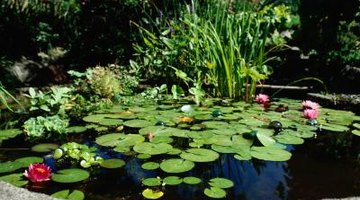How to Seal a Pond With Gypsum
Gypsum is a calcifying agent that is useful geologically for rock formation. It can be useful when sealing a pond. The process takes slightly longer than many land- or homeowners have time for, but gypsum is worth looking into. Once applied, gypsum settles at the bottom of the pond and slowly calcifies, forming barriers against water drainage.

Step 1
Visit your local agricultural supply store to obtain the amount of gypsum necessary to make an impact. They'll be able to provide more specific guidance that is relevant to the soil types in your area, particularly with regard to the salinity of soils, which has a significant effect on the usefulness of gypsum.
Step 2
Apply gypsum as evenly as possible throughout the pond. It can simply be scattered on the surface, as it will sink to the bottom naturally. For the best long-term calcification effects, remove or turn off pond circulators, fountains or other implements that cause the pond water to move around.
Step 3
Use gypsum to obtain short-term results in ponds that are excessively muddy or have a lot of of clay suspended in the water. Gypsum is useful in clearing these ponds due to a natural bond between the gypsum and the clay which swiftly conducts the suspended mud and clay to the bottom of the pond. Though the gypsum will not calcify right away, the clay and mud will provide pond sealing functions in the short term, as well as clearing the water.
Step 4
Wait several days after application to see if the pond clears. If there is some improvement but it is not complete, apply gypsum again. The more suspended mud and clay you can usher to the pond bed, the better your pond will retain water.
References
Photo Credits
- Ryan McVay/Photodisc/Getty Images
More Articles



